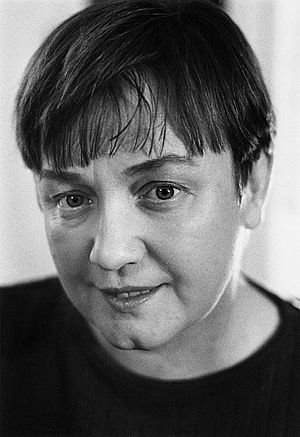Krystyna Kuperberg facts for kids
Quick facts for kids
Krystyna M. Kuperberg
|
|
|---|---|

Krystyna Kuperberg in 1990
|
|
| Born | July 17, 1944 Tarnów, Poland
|
| Nationality | Polish, American |
| Alma mater | University of Warsaw (M.S.) Rice University (Ph.D.) |
| Known for | Smooth counter-example to the Seifert conjecture |
| Awards |
|
| Scientific career | |
| Fields | Topology Dynamical systems |
| Institutions | Auburn University |
| Doctoral advisors | Karol Borsuk William Jaco |
Krystyna M. Kuperberg, born Krystyna M. Trybulec on July 17, 1944, is a famous Polish-American mathematician. She is a professor of mathematics at Auburn University. She is known for her important work in a field of math called topology and dynamical systems.
Contents
Early Life and Family
Krystyna grew up in Tarnów, Poland. Her parents, Jan and Barbara Trybulec, were pharmacists and owned a pharmacy. Her older brother, Andrzej Trybulec, is also a mathematician. Krystyna's husband, Włodzimierz Kuperberg, and her son, Greg Kuperberg, are also mathematicians. Her daughter, Anna Kuperberg, is a photographer.
Education and Career Path
Krystyna went to high school in Gdańsk. In 1962, she started studying mathematics at the University of Warsaw. She found a special interest in topology, which is a branch of mathematics that studies shapes and spaces. She learned a lot from her professor, Karol Borsuk.
After getting her first degree, Krystyna continued her studies in Warsaw. She earned her master's degree there. In 1969, she moved to Sweden with her family. Then, in 1972, they moved to the United States. She finished her Ph.D. (a high-level degree) in 1974 at Rice University. In the same year, both Krystyna and her husband became professors at Auburn University. From 1996 to 1998, she was an important member of the American Mathematical Society Council.
Important Discoveries in Math
Krystyna Kuperberg has solved several challenging math problems. In 1987, she solved a problem about "continua" posed by Bronisław Knaster. Continua are special kinds of connected sets in topology.
In the 1980s, she became very interested in dynamical systems. This field studies how systems change over time. Think of how planets move or how populations grow. In 1989, Kuperberg and Coke Reed solved a problem from the famous Scottish Book. This book was a collection of math problems written by mathematicians in Poland.
Her solution to that problem led to her most famous work in 1993. She created a "smooth counterexample" to the Seifert conjecture. This was a big deal in mathematics. The Seifert conjecture was a long-standing problem about how certain paths behave in 3D spaces. Her work showed that the original idea of the conjecture was not always true. She has continued to work on dynamical systems since then.
Awards and Recognition
Krystyna Kuperberg has received many honors for her work. In 1995, she was given the Alfred Jurzykowski Prize from the Kościuszko Foundation. She has also given important lectures at major math conferences. These include a lecture for the American Mathematical Society in 1995 and another for the Mathematical Association of America in 1996. She also gave an invited talk at the International Congress of Mathematicians in 1998.
In 2012, she became a fellow of the American Mathematical Society. This means she was recognized as a top mathematician. In 2025, she was chosen as a Foreign Member of the Polish Academy of Arts and Sciences.
See also
 In Spanish: Krystyna Kuperberg para niños
In Spanish: Krystyna Kuperberg para niños

